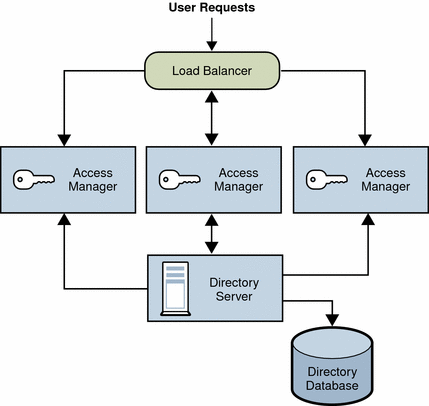Using a Load Balancer
In most deployments, Access Manager is configured with a load balancer to distribute user requests between two or more Access Manager instances. The load balancer can be implemented with hardware, software, or a combination of both. The following figure shows an Access Manager deployment with a load balancer.
Figure 5–1 Access Manager Configuration With a Load Balancer

Cookie-Based Sticky Request Routing
A load balancer deployed with Access Manager must support sticky sessions. A sticky session specifies that once a session is created by a specific Access Manager instance, subsequent requests from the user will continue to be routed to that same instance, in order to preserve session information. Because Access Manager uses cookies to relay session information, the load balancer must redirect the request to the Access Manager instance that created the session.
Therefore, Access Manager has implemented cookie-based sticky request routing, which prevents a client request from being misrouted to an incorrect Access Manager server (that is, to a server that is not hosting the session). This feature prevents the need for back-channel communication between servers and thus improves Access Manager performance.
For more information, see Configuring Cookie-Based Sticky Request Routing in Sun Java System Access Manager 7.1 Postinstallation Guide.
- © 2010, Oracle Corporation and/or its affiliates
